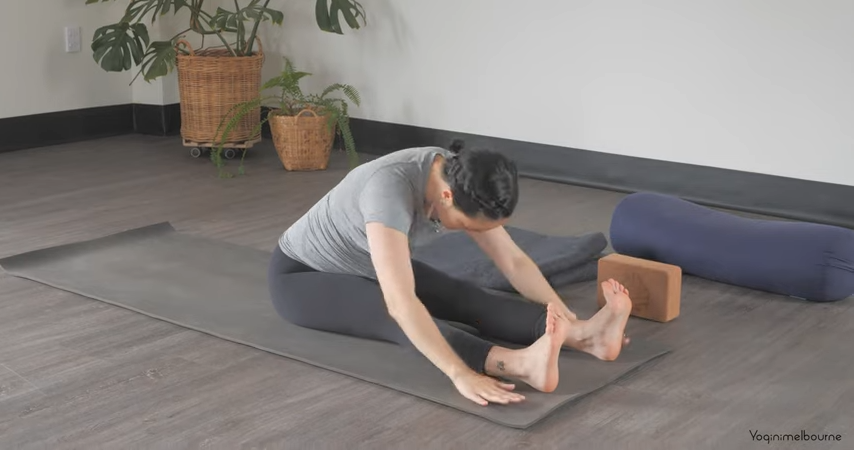Discover how the relaxin hormone affects the body and its potential role in causing back pain.
How Does Relaxin Hormone Contribute to Back Pain?
If you’ve ever experienced back pain, you know how debilitating it can be. But have you ever heard of the relaxin hormone and its connection to back pain? Relaxin hormone is a fascinating substance produced by the body that plays a role in various physiological processes. In this article, we will explore the relationship between relaxin hormone and back pain, as well as ways to manage and prevent it.

Understanding the Role of Relaxin Hormone in the Body
Before delving into relaxin hormone’s impact on the back, let’s first understand its function in the body. Relaxin hormone is a peptide hormone that is mainly known for its role in pregnancy, where it helps soften and loosen the ligaments and connective tissues to prepare for childbirth.
However, relaxin hormone is not exclusive to pregnancy. It is also present in both men and non-pregnant women, although at lower levels. In these cases, the hormone contributes to the maintenance and repair of connective tissues throughout the body.
Relaxin hormone is produced by the corpus luteum in the ovaries in females and by the prostate gland in males. Its release is regulated by various factors, including hormonal fluctuations, physical activity, and stress levels.
The Function of Relaxin Hormone in Pregnancy
In pregnancy, relaxin hormone works its magic by relaxing the ligaments and joints in the pelvis, allowing for greater flexibility during childbirth. This hormone helps to widen the pelvic girdle and increase the mobility of the sacroiliac joints, which are the joints connecting the sacrum and the ilium bones in the pelvis.
By loosening these ligaments and joints, relaxin hormone facilitates the passage of the baby through the birth canal. It also helps to prevent any potential damage to the mother’s pelvis during the delivery process.
However, this relaxation can extend beyond the pelvis, affecting other areas such as the spine and causing back pain. The increased flexibility and decreased stability in the pelvic region can lead to altered biomechanics and increased stress on the spinal structures, resulting in discomfort and pain.
The Effects of Relaxin Hormone on Connective Tissues
Outside of pregnancy, the relaxin hormone continues to affect connective tissues. It helps maintain the elasticity and strength of ligaments, tendons, and joints, ensuring their proper function and stability.
Relaxin hormone promotes collagen remodeling, which is the process of breaking down and rebuilding collagen fibers in connective tissues. This remodeling helps to maintain the integrity and flexibility of these tissues, allowing for smooth movement and preventing injuries.
However, excessive relaxin hormone release, which can occur during hormonal fluctuations, can lead to destabilization of the spine and subsequent back pain. The increased flexibility in the ligaments and joints can result in joint hypermobility and instability, predisposing individuals to musculoskeletal issues.
It is important to note that while relaxin hormone plays a crucial role in maintaining the health and function of connective tissues, an imbalance in its levels can have negative effects. Too little relaxin hormone can lead to stiffness and reduced flexibility, while excessive levels can lead to joint instability and pain.
Understanding the role of relaxin hormone in the body is essential for comprehending its impact on various physiological processes, particularly during pregnancy and in the musculoskeletal system. Further research is still needed to fully elucidate the intricate mechanisms by which relaxin hormone functions and its potential therapeutic applications.
The Link Between Relaxin Hormone and Back Pain
Now that we have a grasp on relaxin hormone’s role in the body, let’s explore its connection to back pain. One way the hormone can contribute to back pain is through the relaxation of ligaments in the spine.
When the relaxin hormone is released in the body, it acts on the ligaments in the spine, causing them to become more flexible and pliable. This increased flexibility can lead to instability and improper alignment of the vertebrae, which in turn can result in discomfort and pain in the back.
Imagine the ligaments in the spine as rubber bands that hold the vertebrae together. When these ligaments become too relaxed, they lose their ability to provide adequate support and stability to the spine. This lack of support can lead to the vertebrae shifting out of their proper positions, putting pressure on the surrounding nerves and causing pain.
Relaxin Hormone and the Relaxation of Ligaments in the Spine
As mentioned before, relaxin hormone promotes the relaxation of ligaments. When this occurs in the spine, it can lead to instability and improper alignment of the vertebrae, causing discomfort and pain in the back.
Furthermore, the relaxation of ligaments in the spine can also affect the intervertebral discs. These discs act as cushions between the vertebrae, absorbing shock and allowing for smooth movement of the spine. However, when the ligaments become overly relaxed, the discs may become compressed or displaced, leading to further pain and potential damage to the spine.
It is important to note that the relaxation of ligaments in the spine due to the release of relaxin hormone is a natural process that occurs during pregnancy. This hormone helps prepare the body for childbirth by loosening the ligaments in the pelvic area. However, in some cases, the effects of relaxin hormone can extend beyond the pelvic region and affect the ligaments in the spine, leading to back pain.
Relaxin Hormone and the Impact on Spinal Stability
Another factor that can contribute to back pain is the impact of relaxin hormone on spinal stability. The excess release of relaxin hormone can weaken the supporting structures of the spine, including the muscles and ligaments, making the back more prone to injury and pain.
When the muscles and ligaments that support the spine are weakened, they are less able to provide the necessary stability and protection to the spinal column. This can result in increased stress on the vertebrae and discs, leading to pain and discomfort.
Moreover, the impact of relaxin hormone on spinal stability can also affect the overall posture and alignment of the body. When the supporting structures of the spine are compromised, it can lead to postural imbalances and misalignments, which can further contribute to back pain.
It is worth noting that while relaxin hormone is primarily associated with pregnancy, it can also be released in smaller amounts during other times in a person’s life. This means that individuals who are not pregnant may still experience the effects of relaxin hormone on their back and spine, potentially leading to back pain.
Common Causes of Back Pain Related to Relaxin Hormone
Now that we know how relaxin hormone can contribute to back pain, let’s explore some common causes of this discomfort, particularly in relation to hormonal fluctuations during pregnancy.

Pregnancy-Related Back Pain and Relaxin Hormone
Pregnant women experience an increase in relaxin hormone levels to facilitate the changes needed for childbirth. However, this hormonal surge can lead to excessive loosening of the ligaments in the spine, resulting in back pain.
During pregnancy, the body undergoes numerous changes to accommodate the growing fetus. The relaxin hormone, produced by the ovaries and placenta, plays a crucial role in preparing the body for childbirth. It helps to relax and soften the ligaments and joints in the pelvis, allowing for easier passage of the baby through the birth canal. Unfortunately, this hormone doesn’t just affect the pelvis; it also affects other parts of the body, including the spine.
The loosening of ligaments in the spine can lead to instability and misalignment of the vertebrae, causing discomfort and pain. The increased flexibility in the joints can also put additional stress on the muscles and tendons supporting the spine, further contributing to back pain.
It’s important to note that not all pregnant women experience back pain related to relaxin hormone. Factors such as genetics, pre-existing back conditions, and overall physical fitness can influence the severity and occurrence of back pain during pregnancy.
Other Factors that Contribute to Relaxin Hormone-Induced Back Pain
While hormonal fluctuations are a major contributor to back pain associated with relaxin hormone, it’s important to note that other factors can exacerbate the discomfort. These include poor posture, excessive weight gain, and lack of muscle strength and flexibility.
Poor posture, such as slouching or hunching over, can put unnecessary strain on the spine and lead to back pain. This is especially true during pregnancy when the body’s center of gravity shifts due to the growing belly. Maintaining good posture and using ergonomic supports, such as pillows or backrests, can help alleviate some of the stress on the spine.
Excessive weight gain during pregnancy can also contribute to back pain. The additional weight puts extra pressure on the spine, causing discomfort and strain. It’s important for pregnant women to maintain a healthy weight and engage in regular exercise, with the guidance of a healthcare professional, to minimize the impact on the back.
Furthermore, lack of muscle strength and flexibility can make the back more susceptible to pain and injury. Weak core muscles, in particular, can lead to poor spinal stability and alignment. Engaging in exercises that target the core, such as prenatal yoga or Pilates, can help strengthen the muscles supporting the spine and reduce back pain.
It’s worth mentioning that while relaxin hormone-induced back pain is common during pregnancy, it usually resolves on its own after childbirth. However, if the pain persists or becomes severe, it’s important to consult with a healthcare professional for proper diagnosis and treatment.
Managing and Treating Back Pain Caused by Relaxin Hormone
Now that we understand the causes of back pain related to relaxin hormone, let’s explore some strategies for managing and treating this discomfort.
Exercise and Physical Therapy for Relaxin Hormone-Related Back Pain
Physical activity and targeted exercises can help strengthen the muscles supporting the spine, improving stability and reducing pain. Engaging in appropriate exercises and working with a physical therapist can provide relief and promote better overall spinal health.
Medications and Pain Management Techniques for Relaxin Hormone-Induced Back Pain
In more severe cases, healthcare professionals may recommend pain medication or other pain management techniques to alleviate discomfort associated with relaxin hormone-induced back pain. It is important to consult a healthcare provider for personalized treatment options.
Preventing Back Pain Associated with Relaxin Hormone
Prevention is always better than cure. To minimize the occurrence and severity of back pain related to relaxin hormone, consider implementing these preventive measures.
Strengthening Exercises to Support the Spine during Relaxin Hormone Release
Incorporating exercises that target core muscles and promote spinal stability can help prevent back pain during relaxin hormone release. Strengthening the muscles surrounding the spine provides vital support and reduces the strain on ligaments.
Ergonomic Tips for Reducing Back Pain during Relaxin Hormone Fluctuations
Simple ergonomic changes in your daily routine can make a big difference in reducing back pain. Maintaining good posture, using supportive furniture and equipment, and avoiding prolonged periods of sitting or standing can help alleviate discomfort caused by relaxin hormone fluctuations.
In conclusion, while relaxin hormone plays a critical role in the body, it can also contribute to back pain. Understanding the connection between relaxin hormone and back pain empowers individuals to explore proactive measures to manage and prevent discomfort. By adopting a comprehensive approach that involves exercise, proper posture, and ergonomic adjustments, you can minimize the impact of relaxin hormone on your spine and enjoy a pain-free life.



